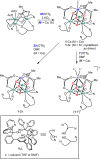Reduction potentials of heterometallic manganese-oxido cubane complexes modulated by redox-inactive metals
- PMID: 23744039
- PMCID: PMC3690856
- DOI: 10.1073/pnas.1302677110
Reduction potentials of heterometallic manganese-oxido cubane complexes modulated by redox-inactive metals
Abstract
Understanding the effect of redox-inactive metals on the properties of biological and heterogeneous water oxidation catalysts is important both fundamentally and for improvement of future catalyst designs. In this work, heterometallic manganese-oxido cubane clusters [MMn3O4] (M = Sr(2+), Zn(2+), Sc(3+), Y(3+)) structurally relevant to the oxygen-evolving complex (OEC) of photosystem II were prepared and characterized. The reduction potentials of these clusters and other related mixed metal manganese-tetraoxido complexes are correlated with the Lewis acidity of the apical redox-inactive metal in a manner similar to a related series of heterometallic manganese-dioxido clusters. The redox potentials of the [SrMn3O4] and [CaMn3O4] clusters are close, which is consistent with the observation that the OEC is functional only with one of these two metals. Considering our previous studies of [MMn3O2] moieties, the present results with more structurally accurate models of the OEC ([MMn3O4]) suggest a general relationship between the reduction potentials of heterometallic oxido clusters and the Lewis acidities of incorporated cations that applies to diverse structural motifs. These findings support proposals that one function of calcium in the OEC is to modulate the reduction potential of the cluster to allow electron transfer.
Keywords: electrochemistry; heterometallic complexes; manganese clusters; model complexes; photosynthesis.
Conflict of interest statement
The authors declare no conflict of interest.
Figures






Similar articles
-
Redox-inactive metals modulate the reduction potential in heterometallic manganese-oxido clusters.Nat Chem. 2013 Apr;5(4):293-9. doi: 10.1038/nchem.1578. Epub 2013 Mar 3. Nat Chem. 2013. PMID: 23511417 Free PMC article.
-
Role of redox-inactive metals in controlling the redox potential of heterometallic manganese-oxido clusters.Photosynth Res. 2021 Jun;148(3):153-159. doi: 10.1007/s11120-021-00846-y. Epub 2021 May 28. Photosynth Res. 2021. PMID: 34047897 Free PMC article.
-
Redox potential tuning by redox-inactive cations in nature's water oxidizing catalyst and synthetic analogues.Phys Chem Chem Phys. 2016 Apr 28;18(16):10739-50. doi: 10.1039/c5cp07213a. Phys Chem Chem Phys. 2016. PMID: 26762578
-
Water exchange in manganese-based water-oxidizing catalysts in photosynthetic systems: from the water-oxidizing complex in photosystem II to nano-sized manganese oxides.Biochim Biophys Acta. 2014 Sep;1837(9):1395-410. doi: 10.1016/j.bbabio.2014.03.008. Epub 2014 Mar 29. Biochim Biophys Acta. 2014. PMID: 24685431 Review.
-
Uncovering structure-activity relationships in manganese-oxide-based heterogeneous catalysts for efficient water oxidation.ChemSusChem. 2015 Mar;8(5):776-85. doi: 10.1002/cssc.201402812. Epub 2015 Jan 30. ChemSusChem. 2015. PMID: 25641823 Review.
Cited by
-
Lewis versus Brønsted Acid Activation of a Mn(IV) Catalyst for Alkene Oxidation.Inorg Chem. 2019 Nov 4;58(21):14924-14930. doi: 10.1021/acs.inorgchem.9b02737. Epub 2019 Oct 18. Inorg Chem. 2019. PMID: 31625380 Free PMC article.
-
S = 3 Ground State for a Tetranuclear MnIV4O4 Complex Mimicking the S3 State of the Oxygen-Evolving Complex.J Am Chem Soc. 2020 Feb 26;142(8):3753-3761. doi: 10.1021/jacs.9b10371. Epub 2020 Feb 18. J Am Chem Soc. 2020. PMID: 32013412 Free PMC article.
-
Heterometallic triiron-oxo/hydroxo clusters: effect of redox-inactive metals.J Am Chem Soc. 2013 Dec 26;135(51):19075-8. doi: 10.1021/ja4104974. Epub 2013 Dec 16. J Am Chem Soc. 2013. PMID: 24304416 Free PMC article.
-
Molecular Mixed-Metal Manganese Oxido Cubanes as Precursors to Heterogeneous Oxygen Evolution Catalysts.Chemistry. 2015 Sep 14;21(38):13420-30. doi: 10.1002/chem.201501104. Epub 2015 Aug 4. Chemistry. 2015. PMID: 26246131 Free PMC article.
-
Harnessing the active site triad: merging hemilability, proton responsivity, and ligand-based redox-activity.Dalton Trans. 2020 Jan 28;49(4):960-965. doi: 10.1039/c9dt04470a. Epub 2020 Jan 7. Dalton Trans. 2020. PMID: 31907502 Free PMC article.
References
-
- Yocum CF. The calcium and chloride requirements of the O2 evolving complex. Coord Chem Rev. 2008;252(3-4):296–305.
-
- Ghanotakis DF, Babcock GT, Yocum CF. Calcium reconstitutes high rates of oxygen evolution in polypeptide depleted Photosystem II preparations. FEBS Lett. 1984;167(1):127–130.
-
- Vrettos JS, Stone DA, Brudvig GW. Quantifying the ion selectivity of the Ca2+ site in photosystem II: Evidence for direct involvement of Ca2+ in O2 formation. Biochemistry. 2001;40(26):7937–7945. - PubMed
-
- Lee C-I, Lakshmi KV, Brudvig GW. Probing the functional role of Ca2+ in the oxygen-evolving complex of photosystem II by metal ion inhibition. Biochemistry. 2007;46(11):3211–3223. - PubMed
-
- Pecoraro VL, Baldwin MJ, Caudle MT, Hsieh WY, Law NA. A proposal for water oxidation in photosystem II. Pure Appl Chem. 1998;70(4):925–929.
Publication types
MeSH terms
Substances
LinkOut - more resources
Full Text Sources
Other Literature Sources
Research Materials

